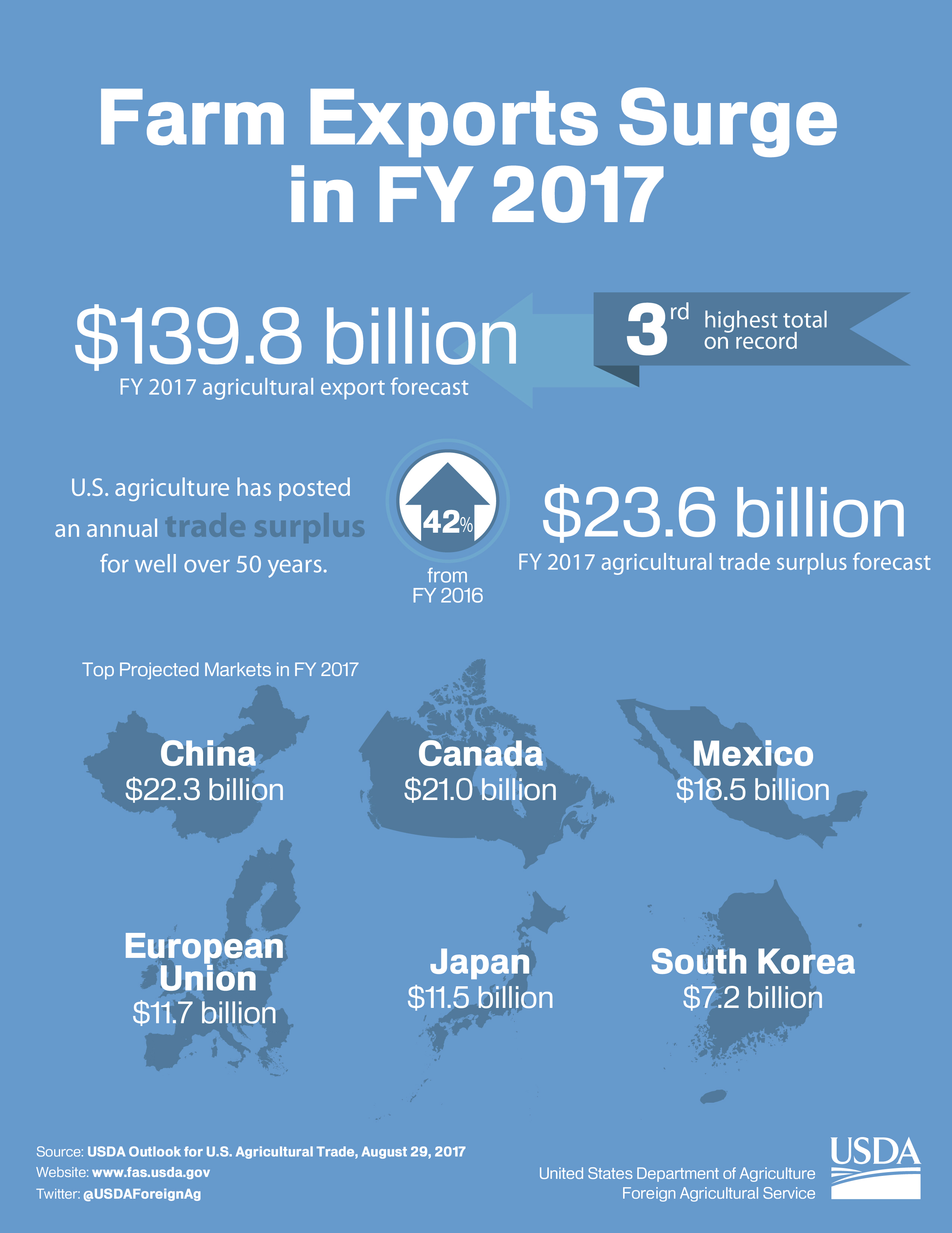Key points:
- President Trump is preparing to withdraw from the South Korea–U.S. (KORUS) free-trade agreement.
- This represents the third free-trade agreement from which the U.S. has withdrawn (e.g., Trans-Pacific Partnership) or is under serious threat (e.g., North American Free Trade Agreement and KORUS) since January 2017.
- Trade partners of the TPP, NAFTA, and KORUS represent four of the largest destinations for U.S. agricultural products, projected to import 42% of the overall value of U.S. agricultural exports in FY2017.
- In 2016, beef trade with South Korea represented approximately 17% of the total value of U.S. beef exports: that’s nearly $1 for every $5 that U.S. beef producers received from exports.
On a slow news day—September 2, 2017, the Saturday of the extended Labor Day weekend—I started seeing a trickle of stories that the Trump administration is preparing withdrawing from the South Korea–U.S. free-trade agreement (KORUS). While these reports were primarily focused on the geopolitical and military implications of this announcement (for example, see here and here), my first thought was (naturally): Is this another potential economic blow to the U.S. agricultural industry?
As my colleagues and I have discussed in previous posts, maintaining a strong presence on the global trade market is economically critical for the U.S. (and particularly the northern Great Plains) agricultural sector. The USDA Foreign Agricultural Service infographic below provides a summary of the economic contributions of trade.

What is particularly important to note in the infographic is that four of the six largest U.S. agricultural product importers have or have the potential to be affected by the Trump administration’s international policy. Recall that on January 23, 2017, the United States withdrew from the Trans-Pacific Partnership, which would have significantly decreased beef and grain product tariffs in Japan. The average agricultural tariff in Japan is 14%, which is nearly three times higher than the average tariff that U.S. agricultural products face, and placed a 38.5–50% tariff on frozen beef. Additionally, there is continued uncertainty about how (or whether) the North American Free Trade Agreement (NAFTA) will be renegotiated. While the results of research about the economic impacts of NAFTA have varied, there is a general consensus that the U.S. agricultural sector has benefited.
It’s also important to note that withdrawing from the TPP, NAFTA, and/or KORUS would certainly not eliminate trade among the United States and countries that are represented by those free-trade agreements. Instead, countries would simply need to comply by the rules set by the World Trade Organization. However, countries that are not operating under free-trade agreements would be able to set significantly trade restrictions. This could result in adverse impacts on the value that U.S. agricultural producers obtained from trade with Canada, Japan, Mexico, and South Korea—partners in NAFTA, KORUS, and the TPP. In 2017, these four partners represent 42% of the value of U.S. agricultural trade, so any barriers to continuing or expanding free trade with these countries is likely to trickle down to U.S. food producers.
How much impact would withdrawing from the KORUS have on U.S. producers? A rigorous answer would require serious economic analysis, but the table below provides a quick snapshot of relative export value (in billions of dollars) of agricultural products with South Korea in 2011 (immediately before the implementation of KORUS) and in 2016. The table provides suggestive evidence that both the livestock and wheat sectors may have gained from participation in the KORUS.
| Jan-Dec 2011 | Jan-Dec 2016 | |||||
| To S. Korea | All Exports | % to S. Korea | To S. Korea | All Exports | % to S. Korea | |
| Beef & Beef Products | $0.69 | $5.42 | 13% | $1.07 | $6.36 | 17% |
| Corn | $1.82 | $13.65 | 13% | $0.86 | $9.89 | 9% |
| Live Animals | $0.02 | $0.95 | 2% | $0.02 | $0.65 | 3% |
| Soybean Meal | $0.08 | $3.19 | 2% | $0.01 | $4.07 | 0% |
| Soybeans | $0.27 | $17.59 | 2% | $0.23 | $22.82 | 1% |
| Wheat | $0.47 | $11.14 | 4% | $0.25 | $5.35 | 5% |
Notes: Values are in billions of 2016 U.S. dollars. Data are from the USDA Foreign Agricultural Service.
And how important are exports to the northern Great Plains region? In 2015, (the latest year for which the USDA Foreign Agricultural Service provides data), livestock products accounted for 10.3% of all international agricultural export value for Idaho, Montana, North Dakota, South Dakota, and Wyoming; wheat and other grain byproducts accounted for 32.4% of all export value, soybeans and soybean meal accounted for 21.7%, and corn accounted for 5.4%. In total, these four agricultural products represent nearly 70% of international export value for these five northern Great Plains states.
While the geopolitical and agribusiness relationships established during the NAFTA and KORUS periods will certainly remain at least to some extent, the implementation of some trade restrictions will occur upon withdrawal and there will be increased uncertainty about future possible trade barriers. These are likely to reduce export market availability for U.S. producers and place downward pressure on farm-level profitability.
How concerned are you about the possible withdrawal from KORUS? Have you experienced positive or negative impacts of free-trade agreements on your operation? Leave your comments below.
(Photo by aaronparecki is licensed under CC BY 4.0)

